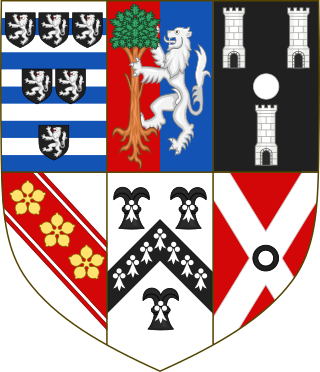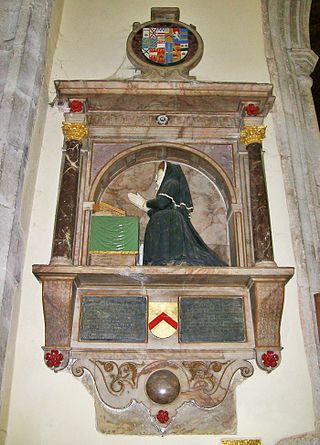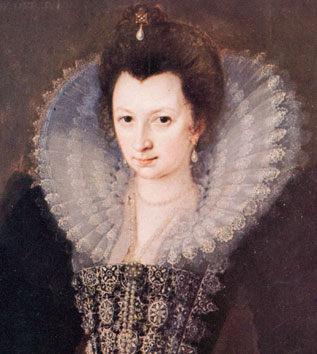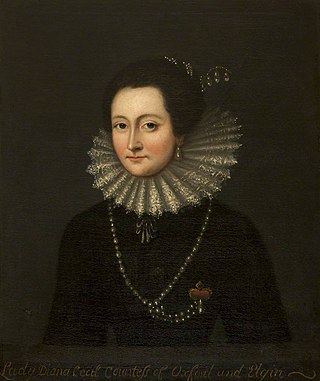
Edward de Vere, 17th Earl of Oxford was an English peer and courtier of the Elizabethan era. Oxford was heir to the second oldest earldom in the kingdom, a court favourite for a time, a sought-after patron of the arts, and noted by his contemporaries as a lyric poet and court playwright, but his volatile temperament precluded him from attaining any courtly or governmental responsibility and contributed to the dissipation of his estate.
John de Vere, 13th Earl of Oxford, the second son of John de Vere, 12th Earl of Oxford, and Elizabeth Howard, a first cousin of John Howard, 1st Duke of Norfolk, was one of the principal Lancastrian commanders during the English Wars of the Roses.

William Cecil, 2nd Earl of Exeter,, known as the third Lord Burghley from 1605 to 1623, was an English nobleman, politician, and peer.

John de Vere, 15th Earl of Oxford, Lord Great Chamberlain KGPC was an English peer and courtier.

Elizabeth de Vere, Countess of Oxford was an English noblewoman. As a young child she became a royal ward.

Elizabeth Hastings, later Countess of Worcester was a noblewoman born in Scotland to Francis Hastings, 2nd Earl of Huntingdon, and Catherine Pole. On 16 December 1571 at Whitehall Palace in a triple wedding with Edward de Vere, 17th Earl of Oxford and bride, Anne Cecil, and Edward Sutton, 4th Baron Dudley and bride, Mary Howard, she married Sir Edward Somerset, 4th Earl of Worcester, son of Sir William Somerset, 3rd Earl of Worcester and Christian North.

Elizabeth Stafford, also known as Dame Elizabeth Drury and – in the years prior to her death in 1599 – Dame (Lady) Elizabeth Scott, was a Lady of the Bedchamber to Queen Elizabeth I. She and her first husband, Sir William Drury, entertained Queen Elizabeth I at Hawstead in 1578.

Henry de Vere, 18th Earl of Oxford KB was an English aristocrat, courtier and soldier.
Bridget Norris, Countess of Berkshire was an English noblewoman, the daughter of Edward de Vere, 17th Earl of Oxford. Bridget was brought up by her maternal grandfather, the powerful statesman William Cecil, 1st Baron Burghley. She was also styled Lady Norris of Rycote and Viscountess Thame. She married Francis Norris, 1st Earl of Berkshire; however, the marriage was not a success, and they separated in 1606.

Elizabeth Stanley, Countess of Derby, Lord of Mann, was an English noblewoman and courtier. She was the eldest daughter of the Elizabethan courtier and poet Edward de Vere, 17th Earl of Oxford.

Anne de Vere, Countess of Oxford was the daughter of the statesman William Cecil, 1st Baron Burghley, chief adviser to Queen Elizabeth I of England, and the translator Mildred Cooke. In 1571 she became the first wife of Edward de Vere, 17th Earl of Oxford. She served as a Maid of Honour to Queen Elizabeth before her marriage.

Susan Herbert, Countess of Montgomery, was an English court office holder. She served as lady-in-waiting to the queen consort of England and Scotland, Anne of Denmark. She was the youngest daughter of Elizabethan courtier, and poet Edward de Vere, 17th Earl of Oxford.
Thomas Trentham (1538–1587) was an English politician.
Mary de Vere was a 16th-century English noblewoman. The daughter of John de Vere, 16th Earl of Oxford, and his second wife Margery Golding, she married Peregrine Bertie, 13th Baron Willoughby de Eresby. The couple lived with their seven children in Grimsthorpe Castle in Lincolnshire. Following Bertie's death, Lady Willoughby married Sir Eustace Hart. She died on about 24 June 1624.

Rushton Hall in Rushton, Northamptonshire, England, was the ancestral home of the Tresham family from 1438, when William Tresham, a veteran of the Battle of Agincourt and Chancellor of the Duchy of Lancaster bought the estate. In the 20th century the house became a private school and it has now been converted to a luxury hotel. The estate is about 227 acres (92 ha) of which 30 acres (12 ha) are formal gardens. The River Ise flows from west to east south of the Hall.
William Lewin or Lewyn of London and Otterden, Kent, was a college fellow, tutor, ecclesiastical lawyer, and judge. He also served three times as a member of parliament for Rochester.
Margery Golding, Countess of Oxford was the second wife of John de Vere, 16th Earl of Oxford, the mother of Edward de Vere, 17th Earl of Oxford, and the half-sister of Arthur Golding, the English translator.

The House of de Vere was an old and powerful English aristocratic family who derived their name from Ver, in Lower Normandy, France.

Anne Sutton was an English lady-in-waiting who was a companion of Elizabeth Stuart, Queen of Bohemia. She was the daughter of Edward Sutton, 5th Baron Dudley and Theodosia Harington. Sutton was known as "Mrs Anne Dudley" or "Mistress Dudley" although "Sutton" was the family surname. Elizabeth of Bohemia called her "Nan Duddlie".

Diana Cecil, Countess of Oxford (1596–1654) was an English aristocrat. She was a daughter of William Cecil, 2nd Earl of Exeter and his second wife Elizabeth Drury, a daughter of Sir William Drury and Elizabeth Stafford.













